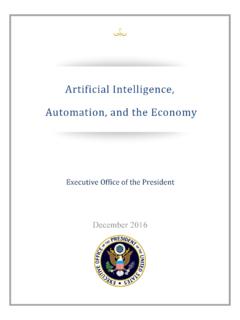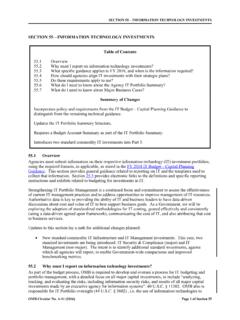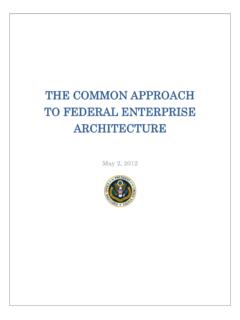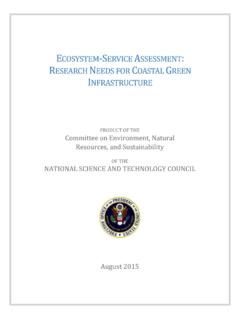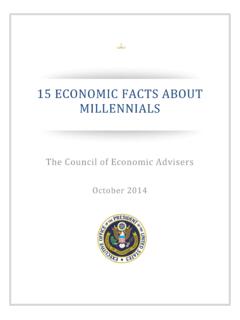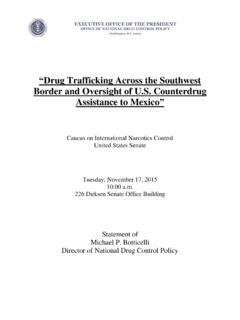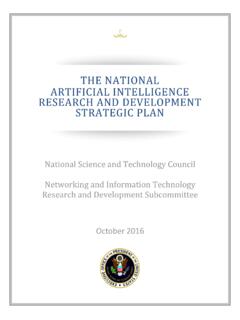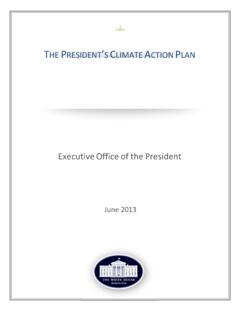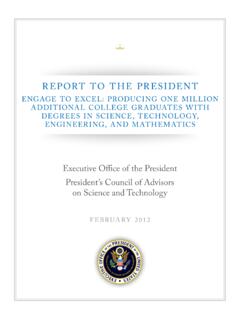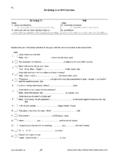Transcription of PREPARING FOR THE FUTURE OF ARTIFICIAL INTELLIGENCE
1 October 2016 PREPARING FOR THE FUTURE OF ARTIFICIAL INTELLIGENCE National Science and Technology Council PREPARING FOR THE FUTURE OF ARTIFICIAL INTELLIGENCE Executive Office of the President National Science and Technology Council Committee on Technology About the National Science and Technology Council The National Science and Technology Council (NSTC) is the principal means by which the Executive Branch coordinates science and technology policy across the diverse entities that make up the Federal research and development (R&D) enterprise. One of the NSTC s primary objectives is establishing clear national goals for Federal science and technology investments. The NSTC prepares R&D packages aimed at accomplishing multiple national goals. The NSTC s work is organized under five committees: Environment, Natural Resources, and Sustainability; Homeland and National Security; Science, Technology, Engineering, and Mathematics (STEM) Education; Science; and Technology.
2 Each of these committees oversees subcommittees and working groups that are focused on different aspects of science and technology. More information is available at About the Office of Science and Technology Policy The Office of Science and Technology Policy (OSTP) was established by the National Science and Technology Policy, Organization, and Priorities Act of 1976. OSTP s responsibilities include advising the President in policy formulation and budget development on questions in which science and technology are important elements; articulating the President s science and technology policy and programs; and fostering strong partnerships among Federal, state, and local governments, and the scientific communities in industry and academia. The Director of OSTP also serves as Assistant to the President for Science and Technology and manages the NSTC. More information is available at Acknowledgments This document was developed through the contributions of staff from OSTP, other components of the Executive Office of the President, and other departments and agencies.
3 A special thanks and appreciation to everyone who contributed. Copyright Information This is a work of the Government and is in the public domain. It may be freely distributed, copied, and translated; acknowledgment of publication by the Office of Science and Technology Policy is appreciated. Any translation should include a disclaimer that the accuracy of the translation is the responsibility of the translator and not OSTP. It is requested that a copy of any translation be sent to OSTP. This work is available for worldwide use and reuse and under the Creative Commons CC0 Universal license. EXECUTIVE OFFICE OF THE PRESIDENT NATIONAL SCIENCE AND TECHNOLOGY COUNCIL WASHINGTON, 20502 October 12, 2016 Dear colleagues: Advances in ARTIFICIAL INTELLIGENCE (AI) technology have opened up new markets and new opportunities for progress in critical areas such as health, education, energy, and the environment.
4 In recent years, machines have surpassed humans in the performance of certain specific tasks, such as some aspects of image recognition. Experts forecast that rapid progress in the field of specialized ARTIFICIAL INTELLIGENCE will continue. Although it is very unlikely that machines will exhibit broadly-applicable INTELLIGENCE comparable to or exceeding that of humans in the next 20 years, it is to be expected that machines will reach and exceed human performance on more and more tasks. As a contribution toward PREPARING the United States for a FUTURE in which AI plays a growing role, this report surveys the current state of AI, its existing and potential applications, and the questions that are raised for society and public policy by progress in AI. The report also makes recommendations for specific further actions by Federal agencies and other actors. A companion document lays out a strategic plan for Federally-funded research and development in AI.
5 Additionally, in the coming months, the Administration will release a follow-on report exploring in greater depth the effect of AI-driven automation on jobs and the economy. The report was developed by the NSTC s Subcommittee on Machine Learning and ARTIFICIAL INTELLIGENCE , which was chartered in May 2016 to foster interagency coordination, to provide technical and policy advice on topics related to AI, and to monitor the development of AI technologies across industry, the research community, and the Federal Government. The report was reviewed by the NSTC Committee on Technology, which concurred with its contents. The report follows a series of public-outreach activities spearheaded by the White House Office of Science and Technology Policy (OSTP) in 2016, which included five public workshops co-hosted with universities and other associations that are referenced in this report. OSTP also published a Request for Information (RFI) in June 2016, which received 161 responses.
6 The submitted comments were published by OSTP on September 6, 2016. Consistent with the role of Big Data as an enabler of AI, this report builds on three previous Administration reports on Big Data referenced in this report. In the coming years, AI will continue to contribute to economic growth and will be a valuable tool for improving the world, as long as industry, civil society, and government work together to develop the positive aspects of the technology, manage its risks and challenges, and ensure that everyone has the opportunity to help in building an AI-enhanced society and to participate in its benefits. Sincerely, John P. Holdren Megan Smith Assistant to the President for Science and Technology Chief Technology Officer Director, Office of Science and Technology Policy National Science and Technology Council Chair John P. Holdren Assistant to the President for Science and Technology and Director, Office of Science and Technology Policy Staff Afua Bruce Executive Director Office of Science and Technology Policy Subcommittee on Machine Learning and ARTIFICIAL INTELLIGENCE Co-Chair Ed Felten Deputy Chief Technology Officer Office of Science and Technology Policy Co-Chair Executive Secretary Terah Lyons Policy Advisor to the Chief Technology Officer Office of Science and Technology Policy Michael Garris Senior Scientist National Institute of Standards and Technology Department of Commerce The following Federal departments and agencies are represented on the Subcommittee on Machine Learning and ARTIFICIAL INTELLIGENCE and through it, work together to monitor the state of the art in machine learning (ML) and AI (within the Federal Government, in the private sector, and internationally)
7 , to watch for the arrival of important technology milestones in the development of AI, to coordinate the use of and foster the sharing of knowledge and best practices about ML and AI by the Federal Government, and to consult in the development of Federal research and development priorities in AI: Department of Commerce (Co-Chair) Department of Defense Department of Education Department of Energy Department of Health and Human Services Department of Homeland Security Department of Justice Department of Labor Department of State Department of Transportation Department of Treasury Department of Veterans Affairs United States Agency for International Development Central INTELLIGENCE Agency General Services Administration National Science Foundation National Security Agency National Aeronautics and Space Administration Office of the Director of National INTELLIGENCE Social Security Administration The following offices of the Executive Office of the President are also represented on the Subcommittee.
8 Council of Economic Advisers Domestic Policy Council Office of Management and Budget Office of Science and Technology Policy (Co-Chair) Office of the Vice President National Economic Council National Security Council PREPARING FOR THE FUTURE OF ARTIFICIAL INTELLIGENCE PREPARING FOR THE FUTURE OF ARTIFICIAL INTELLIGENCE Contents Executive Summary .. 1 Introduction .. 5 A Brief History of AI .. 5 What is ARTIFICIAL INTELLIGENCE ? .. 6 The Current State of AI .. 7 Public Outreach and Development of this Report .. 12 Applications of AI for Public Good .. 13 AI in the Federal Government .. 15 AI and Regulation .. 17 Case Study: Autonomous Vehicles and Aircraft .. 18 Research and Workforce .. 23 Monitoring Progress in 23 Federal Support for AI Research .. 25 Workforce Development and Diversity .. 26 AI, Automation, and the Economy .. 29 Fairness, Safety, and Governance .. 30 Justice, Fairness, and Accountability.
9 30 Safety and 32 Global Considerations and Security .. 35 International Cooperation .. 35 AI and Cybersecurity .. 36 AI in Weapon Systems .. 37 Conclusion .. 39 Recommendations in this Report .. 40 43 References .. 45 PREPARING FOR THE FUTURE OF ARTIFICIAL INTELLIGENCE PREPARING FOR THE FUTURE OF ARTIFICIAL INTELLIGENCE 1 Executive Summary As a contribution toward PREPARING the United States for a FUTURE in which ARTIFICIAL INTELLIGENCE (AI) plays a growing role, we survey the current state of AI, its existing and potential applications, and the questions that are raised for society and public policy by progress in AI. We also make recommendations for specific further actions by Federal agencies and other actors. A companion document called the National ARTIFICIAL INTELLIGENCE Research and Development Strategic Plan lays out a strategic plan for Federally-funded research and development in AI.
10 Applications of AI for Public Good One area of great optimism about AI and machine learning is their potential to improve people s lives by helping to solve some of the world s greatest challenges and inefficiencies. Many have compared the promise of AI to the transformative impacts of advancements in mobile computing. Public- and private-sector investments in basic and applied R&D on AI have already begun reaping major benefits to the public in fields as diverse as health care, transportation, the environment, criminal justice, and economic inclusion. The effectiveness of government itself is being increased as agencies build their capacity to use AI to carry out their missions more quickly, responsively, and efficiently. AI and Regulation AI has applications in many products, such as cars and aircraft, which are subject to regulation designed to protect the public from harm and ensure fairness in economic competition.
